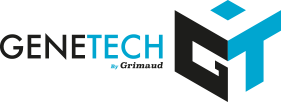Conviction#2
LES TECHNOLOGIES DE MONITORING
Conviction n°2
MONITORING technologies are the second pillar of the Genetech platform by Grimaud.
They make it possible to measure in real time the behaviour and the performances of animals as close to the field conditions as possible. These technologies, which are non-constraining for animals, offers the potential for progress in well-being, animal health and service to breeders in their management program

Technological evolutions mean the animals' performances (weight, body composition, reproduction features, etc.) can be measured with great precision. However, to meet industrial and societal challenges, the animals must be bred in conditions of welfare whilst providing the best performances possible to the breeder.
One of the answers from the Groupe Grimaud faced with these challenges, is to develop technologies allowing for ongoing monitoring of the animals' behaviour and their environment; so that they can be selected to provide excellent performances in varied environments meeting animal welfare criteria (free-range and collective).
The principle is to equip animals with non-invasive captors (of the accelerometre type or RFID - for Radio Frequence Identification) to follow their feeding, laying or social interaction behaviour. Not only does this mean that animals with the best performances in the conditions meeting well-being standards can be selected, but it also means that aggressive behaviour or stress can be reduced.
These approaches are now used on most species selected by the Groupe Grimaud:
- Duck for feeding, laying and social interaction behaviour,
- Layer for laying behaviour,
- Pig for feeding and social interaction behaviour,
- Rabbit for feeding behaviour.
Simultaneously, monitoring the environment in which the animals are bred (via temperature, hygrometry captors...) provides data that makes it possible to better understand the interaction between the environment and genetics, and therefore provide advice to breeders about livestock management. In the end, the combination of this knowledge with the Big Data approaches, developed furthermore, will allow tools for helping decision-making to be implemented.
Benefits
Better measuring accuracy
The monitoring of animals provides more accurate measuring because it is performed in breeding conditions. Thus, the genetic progress made is better expressed by the breeders.
New selection criteria
In addition to significant economic criteria for the field (feeding efficiency, laying intensity...) and for consumers, these technologies enable us to accumulate individual data concerning the animals' behaviour at the manger, nest and amongst themselves. The time spent in the nests or mangers, the number of visits, the number of interactions between animals, the distance moved per day is new information that enables the animals' behaviour to be better understood and to take it into account in our selection objectives.
Animal health and preservation of the environment
These approaches make it possible to make the connection between production and animal welfare. They are also a source of information allowing social interactions to be taken into account in the selection diagrams.
Production criteria selected by these approaches (laying intensity and feeding efficiency) are major levers for resource preservation. In fact, their improvement allows for the potential of subject to be optimised by decreasing the needs in raw materials.
A performance support for the breeders
Knowledge of the impact of the environmental factors on the animal's performance provides the possibility to predict a performance depending on environmental measures and therefore to adjust the breeding management in real time via decision-making tools.
Groupe Grimaud
The mission of the Groupe Grimaud is to further develop know-how and products in the life science field, contributing to the development of efficient solutions for the food and health industries throughout the world.
Our two core businesses are:
- Genetic selection, production and distribution of animal breeding stock, hatching eggs and semen for layers, pigs, ducks, guinea fowls, rabbits, pigeons & shrimps.
- Bio-pharmacy serving human and animal health through vaccines, pharmaceutical proteins and sera, human antibodies, specific pathogen free animals, bacterial cultures.







